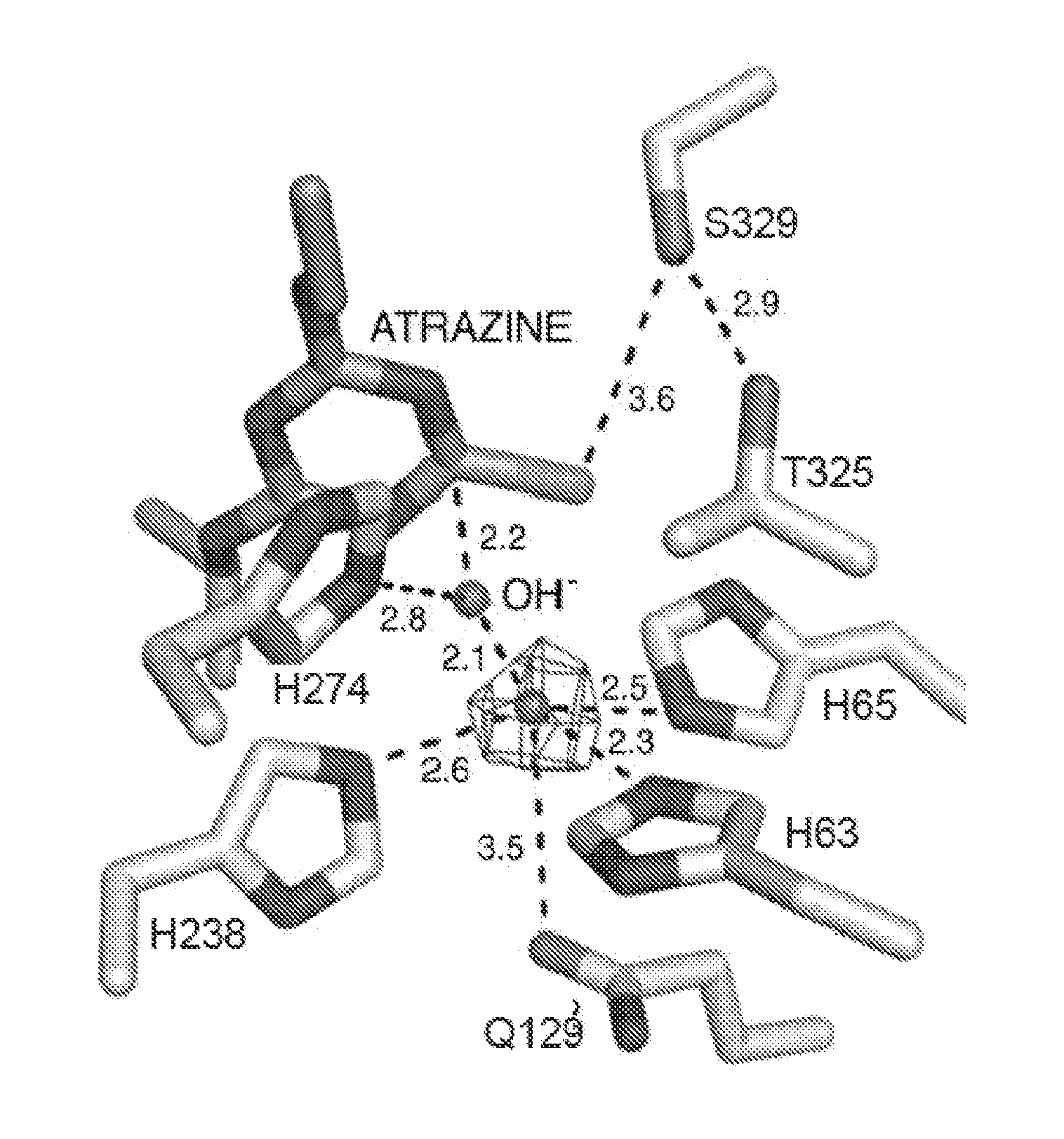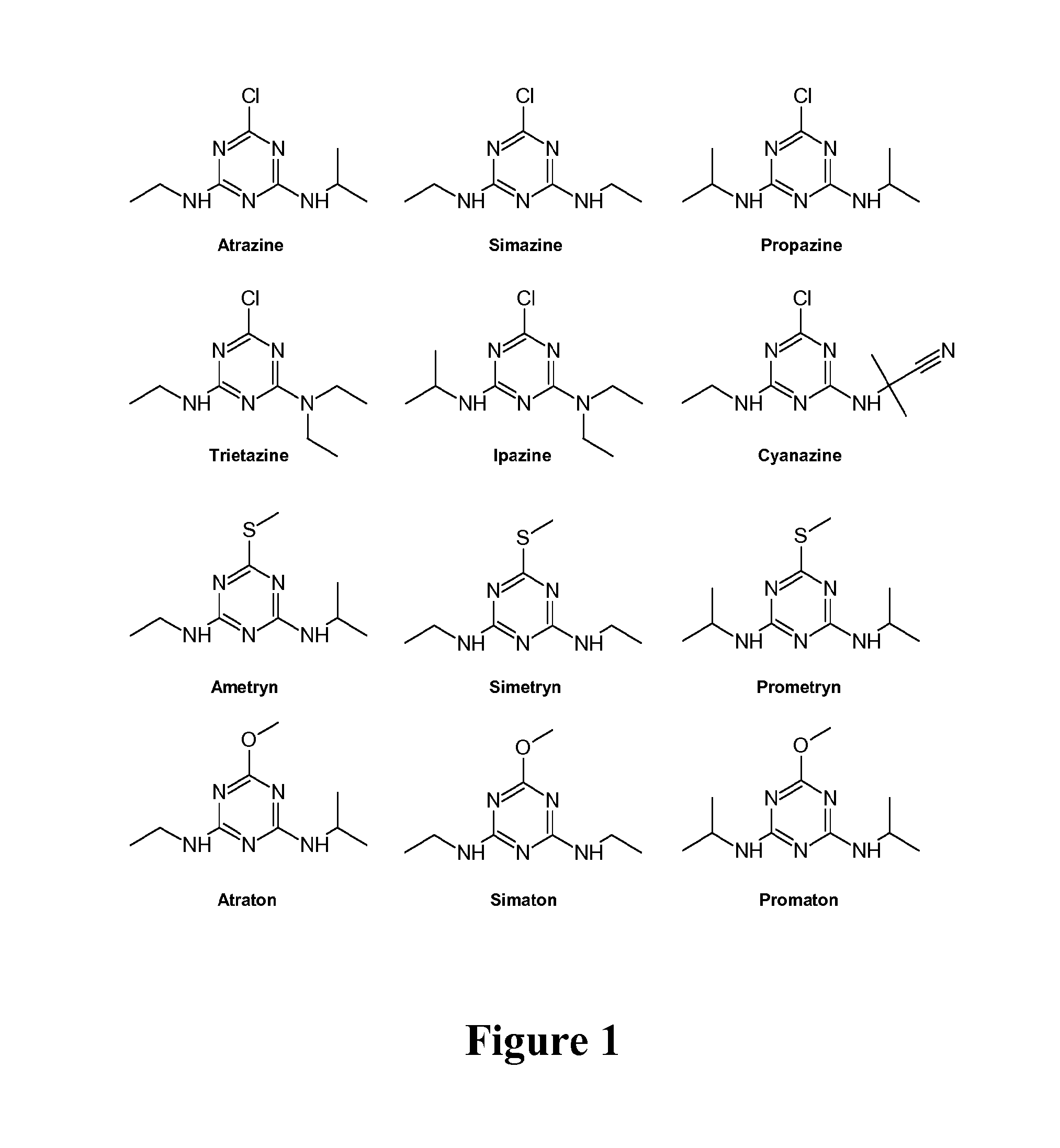Enzymes and methods for degrading s-triazines and diazines
- Summary
- Abstract
- Description
- Claims
- Application Information
AI Technical Summary
Benefits of technology
Problems solved by technology
Method used
Image
Examples
example 1
TrzN Mutants with Enhanced Activity
Methods and Materials
[0430]A truncated pET14b plasmid (pETcc2) was used for the expression of TrzN and its variants. All trzN genes were cloned into pETcc2 using the unique NdeI and BamHI sites, and expressed in E. coli strain BL21 λDE3 (Novagen). NdeI / BamHI digested pETcc2 was prepared from pETcc2::egfp (FIG. 2), which provided a simple visual indication of the proportion of religated vector in the libraries (i.e. relegated vector fluoresced strongly under blue light).
[0431]Codon optimised TrzN (SEQ ID NO:2—TrzNco) was produced by GENEART AG (BioPark, Josef-Engert-Str. 11, D-93053 Regensburg Germany).
[0432]Random mutagenesis was performed using GeneMorph II (Stratagen) according to the manufactures instructions. Oligonucleotide primers 1 and 2 were used to amplify the gene (Table 2).
[0433]Site-saturation mutagenesis was performed by PCR mediated site-directed mutagenesis using primers 3-24, as detailed in Table 2. The NNS degeneracy (Georgescu et ...
example 2
Structure of TrzN Mutants with Enhanced Activity
Methods and Materials
Structure Solution
[0448]Data collection statistics have been reported elsewhere (Jackson et al., 2006). Phase determination using single-wavelength anomalous diffraction (SAD) (Dauter et al., 2002) from the active site metals of metallo-enzymes has been previously reported (Liu et al., 2005). Because previous work suggested that the asymmetric unit contained a TrzN dimer (Jackson et al., 2006), SHELXD (Schneider et al., 2002), as implemented in the CCP4 suite of programs (Collaborative-Computational-Research-Project-4, 1994), was used to locate the positions of the four Zn2+ ion sites in an anomalous difference Patterson synthesis using the SAD data collected at 1.28269 Å. MLPHARE (Otwinowski, 1991) was subsequently used to refine the occupancy of the four sites and obtain initial phases with a phasing power of 2.43. SHELXE was used for density modification and phase improvement (Sheldrick et al., 2002); the high s...
example 3
Field Study
Methods and Materials
Preparation of TrzNcc3.2-Containing Homogenate
[0460]Clarified bacterial homogenate containing active TrzNcc3.2 were prepared from a 2 litre ferment of BL21 λDE3 expressing TrzNcc3.2, grown on a minimal medium (10.6 g / L KH2PO4, 4 g / L (NH4)2HPO4, 1.7 g / L citric acid monohydrate, 31.3 mL / L glycerol). After autoclaving 10 mL / L of PTM4 salts (0.2 g / L D-biotin, 2.0 g / L CuSO4.5H2O, 0.08 g / L NaI, 3.0 g / L MnSO4.H2O, 0.2 g / L Na2MoO4, 0.02 g / L Boric acid, 0.5 g / L CoCl2.6H2O, 7.0 g / L ZnCl2, 22.0 g / L FeSO4.7H2O, 0.5 g / L CaSO4, 1 mL / L H2SO4) and 0.6 g / L MgSO4 was added. The fermentation was fed with glycerol, supplemented with 150 mg / L ampicillin and 331 mg / L thiamine, and induced with 11.9 mg / L IPTG. The ferment yielded ca. 240 g wet weight of cell pellet (OD600=122). The cells were suspended in 5.2 g / L MOPS pH 6.9, then passed through a homogeniser 3 times and clarified by centrifugation. The clarified lysate was passed through a 0.22 μM filter to remove intact c...
PUM
 Login to view more
Login to view more Abstract
Description
Claims
Application Information
 Login to view more
Login to view more - R&D Engineer
- R&D Manager
- IP Professional
- Industry Leading Data Capabilities
- Powerful AI technology
- Patent DNA Extraction
Browse by: Latest US Patents, China's latest patents, Technical Efficacy Thesaurus, Application Domain, Technology Topic.
© 2024 PatSnap. All rights reserved.Legal|Privacy policy|Modern Slavery Act Transparency Statement|Sitemap



